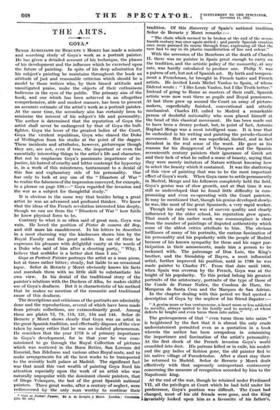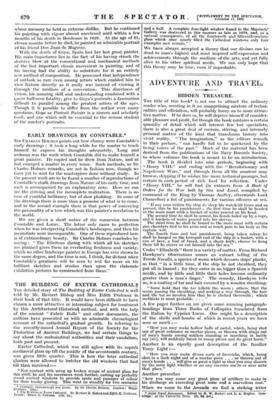THE ARTS.
GOYA.*
SENOR ALTERMAN° DE BERUETE Y MORET has made a minute and searching study of Goya's work as a portrait painter. He has given a detailed account of his technique, the phases of his development and the influence which he exercised upon the future of painting. In spite of his deep admiration for his subject's painting he maintains throughout the book an attitude of just and reasonable criticism which should be a model to those writers who, by their biased attitude and unmitigated praise, make the objects of their enthusiasm ludicrous in the eyes of the public. The primary aim of the book; and one which has been achieved in an altogether comprehensive, able and modest manner, has been to present an accurate estimate of the artist's work as a portrait painter. At the same time, the secondary aim has certainly been to minimize the interest of his subject's life and personality. The author is determined that the reputation of Goya the artist shall never be endangered by that of Goya the bull- fighter, Goya the lover of the greatest ladies of the Court, Goya the virulent republican, Goya who chased the Duke of Wellington from his studio at the point of the dagger. These incidents and attributes, however, picturesque though they are, are not, even if true, the important or even the essentially interesting things in the artist's life and character. But not to emphasize Goya's passionate impatience of in- justice, his hatred of cruelty and bitter contempt for hypocrisy is, in a work of this minuteness, tantamount to a denial of this fine and explanatory side of his personality. One has only to look at any one of the " Disasters of War " to realize the falseness of the impression conveyed, for example, in a phrase on page 136 :—" Goya regarded the invasion and the war as a subject for thoughtful study."
It is obvious in the same way that besides being a great artist he was an advanced and profound thinker. We know that the ideas of the French revolution interested him deeply, though we can see from the " Disasters of War " how futile he knew physical force to be.
Contrary to what is so often said of great men, Goya was vain. He loved the position of Pintor de camera del Rey, and still more his ennoblement. In his letters he describes in a most charming way the kindnesses shown him by the Royal Family and the great nobles. In one of them he expresses his pleasure with delightful vanity at the words of a Duke who said of him after a shooting party, " Why, I believe that scribbler is a better shot than I am."
Goya as Portrait Painter portrays the artist as a man pious, but at times rather bitter; steady, but liable to an occasional lapse. Senor de Beruete y Moret obviously knows his facts and marshals them with no little skill to substantiate his own view. In his denial of the traditional story of the painter's relations with the Duchess of Alba, he makes skilful use of Goya's deafness. But it is characteristic of his method that he makes no mention of the romantic and traditional cause of this deafness.
The descriptions and criticisms of the portraits are admirably done and the reproductions, several of which have been made from private collections, are extraordinarily good. Among these are plates 75, 79, 113, 121, 134 and 144. Seflor de Beruete y Moret shows clearly that Goya was an artist in the great Spanish tradition, and effectually disposes of the view taken by many critics that he was an isolated phenomenon. He considers that the year 1778 is of primary importance in Goya's development, for in that year he was com- missioned to go through the Royal Collection of pictures which was scattered in the Buen Retiro, San Lorenzo del Escorial, San Ildefonso and various other Royal seats, and to make arrangements for all the best works to be transported to the recently built palace at Madrid. The significant fact was that amid this vast wealth of painting Goya fixed his attention especially upon the work of an artist who was naturally unpopular with the dominant classic painters, that of Diego Velasquez, the last of the great Spanish national painters. Them great works, after a century of neglect, were rediscovered by -the only man worthy to continue their
1528..G:ia jr:t)Pergrav PaiNar! BY A. dp ReniEte.k Yoret. London : Constable.
tradition. Of this discovery of Spain's national tradition Senor de Beruete y Moret remarks :— " The chain which seemed to be broken at the end of the seven- teenth century was once againunited ; and purely Spanish creation once more pursued its course through time, expressing all that the race had to say in its plastic manifestation of line and colour."
With the accession of the Bourbons at the death of Charles II. there was no painter in Spain great enough to carry on the tradition, and the artistic policy of the monarchy, at any rate, was hardly calculated to produce one. Philip V. was a patron of art, but not of Spanish art. By birth and tempera- ment a Frenchman, he brought in French tastes and French artists. He invited Louis Michel Vanloo to Spain, of whom Diderot wrote : " I like Louis Vanloo, but I like Truth better."
Instead of going to Rome as masters of their craft, Spanish artists were now sent there as pupils and Royal pensioners. At last there grew up around the Court an army of picture- makers, superficially finished, conventional and utterly mechanical. Charles III. called to Madrid a remarkable person of doubtful nationality who soon placed himself at the head of this classical movement. He has been made out to have been a dreary pedant, but, in point of fact, Antonio Raphael Mengs was a most intelligent man. It is true that he embodied in his writing and painting the pseudo-classical movement. But his art was superficial, limited, and in fact decadent in the real sense of the word. He gave as his reasons for his disapproval of Velasquez and the Spanish seventeenth century painters their ignorance of Greek art and their lack of what he called a sense of beauty, saying that they were merely imitators of Nature without knowing how to select the beauty which it contained. It was the shattering of this view of painting that was to be the most important effect of Goya's work. When Goya came to settle permanently in Madrid, Mengs and his followers completely held the field. Goya's genius was of slow growth, and at that time it was still so undeveloped that he found little difficulty in com- promising and even co-operating with the Court painters. It may be mentioned that, though his genius developed slowly, he was, like most of the great Spaniards, a very rapid worker. Though his early work was of uneven quality and clearly influenced by the older school, his reputation grew apace. That much of his earlier work was commonplace is clear from the number of paintings of disputed authenticity which some of the ablest critics attribute to him. The obvious brilliance of many of his portraits, the curious fascination of
his personality and his popularity with the people of Madrid because of his known sympathy for them and his eager par- ticipation in their amusements, made him a person to be
reckoned with. The patronage of Don Luis, the King's brother, and the friendship of Bayeu, a most influential artist, further improved his position, until in 1789 he was made painter to Charles IV. From that date until 1808, when Spain was overrun by the French, Goya was at the height of his popularity. To this period .belong his. greatest portraits of the aristocracy, portraits of the type of those of the Conde de Fernar Nufiez, the Condesa de Haro, the Marquesa de Santa Cruz and the Marques de San Adrian.
In the chapter dealing with this period we find quoted a description of Goya by the nephew of his friend Zapater :- " A genius more or less venturesome, a heart more or less addicted to novelty, always united to his family and to society, at whose defects he laughs and even turns them into satire."
The grotesqueness of that " even turns them into satire " is heightened by the fact that it is almost the only crude understatement permitted even as a quotation in a book wherein the author has been scrupulous in minimizing the importance and fascination of the artist's personality. At the first shock of the French invasion Goya's world crumbled into dust. His patrons killed or in exile, his models and the gay ladies of fashion gone, the old painter fled to his native village of Fuendetodos. After a short stay there he returned to Madrid. Sefior de Beruete y Moret deals effectively with that supremely unimportant controversy concerning the measure of recognition accorded by him to the Napoleonic king.
At the end of the wait., though he retained -under Ferdinand VII. all the privileges at Court which he had held under his predecessor, Goya's position was difficult. The Court had changed, most - of 'his • old friends were gone, and the King
invariably looked upon him as a favourite of his father's, whose memory he held in extreme dislike. But he continued his 'painting with vigour almost unrelaxed until within a few months of his death in Bordeaux in 1828. At the age of 81, eleven months before he died, he painted an admirable portrait of his friend Don Juan de Maguiro.
With the death of Goya, Spain lost her last great painter. His main importance lies in the fact of his having struck the decisive blow at the conventional and mechanical methods of the last important classic movement in painting, and of his having had the ability to substitute for it an entirely new method of composition. He possessed that independence of outlook so rare even among artists which enabled him to view Nature directly as it really was instead of viewing it through the medium of a convention. This directness of vision, his amazing skill and understanding combined with a queer half-seen fatality, give to Goya's portraits a fascination difficult to parallel among the greatest artists of the ages. Though it is possible to differ from the author over many questions, Goya as Portrait Painter is a sincere and scholarly book, and one which will be essential to the serious student of the master's portraits.



























































 Previous page
Previous page